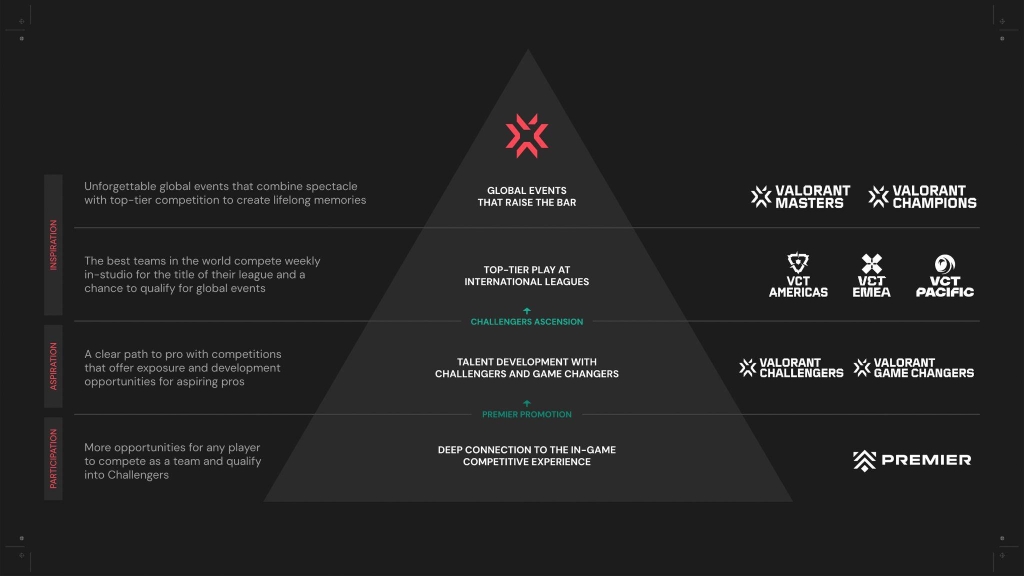The Challengers Leagues will also run year-round instead of ending the season in June.
Riot Games has announced significant changes to the Tier 2 scene with updates on VALORANT Challengers and more. Riot defined its strategy as inspiration, aspiration, and participation in the announcement blog. And there’s a way for every VALORANT player to go pro and climb the pyramid of the VALORANT esports scene. Here are all the details.
What has been Riot’s focus for Challengers?
The Challenger Leagues have been successful with what they set out to achieve. From the scouting of new talent to new teams joining the International Leagues next year, it provides a way for aspirational players to find their way into VCT.
The blog post highlights how some regions have led the way in terms of viewership with the Japanese stream bringing in an impressive 160,000 viewers during Split 1.
Viewership
While viewership is the primary means of evaluating the success or failure of the Tier 2 scene, it is a very important one. Not only does viewership allow tournament operators to monetize their events, it also gives Riot a better understanding of what the fans want.
To put it simply, some leagues are lagging behind on viewership.
The Tier 2 scene, naturally was not as high on viewership as many of the official VCT events. However, Riot acknowledges that the Tier 2 events’ schedule that often coincided with VCT meant it did not receive as many eyeballs as it should have. Highlighting that content fatigue could be a big reason for the lower-than-expected viewership for Challengers, Riot acknowledged their scheduling might not have been perfect.
As per data from ESCharts, the Japanese League amassed more than 14.5 million hours watched across both the Splits. In contrast, the French league only managed to do 3.84 million hours watched despite influencers co-streaming the event. Similarly, Pacific teams were also trailing their Japanese counterparts when it comes to viewership.
Calendar
Further elaborating on the calendar, the Tier 2 competitive scene comes to an end around June or August. And for the rest of the year, the teams have nothing to look forward to in the OFF//SEASON. As such, it becomes difficult for teams to operate in the current format with players also left with little to no competition during this time.
Fewer competitions only mean the players have fewer opportunities to develop and thrive. This brings us to the next point.
A Stepping Stone
Right from the beginning, Riot has specified that the Challengers scene is a stepping stone. It is not the destination but a stop en route for players to showcase their talent and get noticed. The ultimate goal for many players would still remain the International Leagues.
What’s changing next year?

Related articles
VALORANT Challenger Leagues to run year around
Challenger Leagues will run throughout the year as opposed to the current format where teams can play from January to June.
We hope that will give Challengers space during those months and significantly help viewership.
The primary reason for this seems to be to take advantage of the lack of official VCT events during the OFF//SEASON. Furthermore, creators who want to host watch parties will also receive a clear feed which should further drive up interest in the Challenger Leagues.
New Dates for Challengers Ascension
Challengers Ascension moves to September after VCT Champions next year. This will ensure the Ascension receives its own spotlight allowing fans to soak in the competitive nature and spirit of Ascension.
Player Mobility through the Leagues
The VALORANT Challengers and Ascension series are basically stepping stones in the players’ careers. In an effort to ensure players can climb up the ladder if they perform well, Riot has ensured there’s smoother mobility in the scene.
International League teams can now build affiliate relationships with Challenger teams as well as create a new loan system. This will ensure faster and more efficient movement of players between the Tier 2 and Tier 1 scene.
- VCT League teams can build affiliate relationships with Challenger teams
- New Loan system for a smoother transition of players
Final Thoughts
Riot is clearly experimenting with how the Tier 2 system can work. In a bid to make sure the tier 2 scene acts as a stepping stone, but also to make it more viable than its current format, Riot has spread it throughout the year.
But this also will come with some compromises such as lack of stream for some VALORANT Challengers matches. Riot will also have to develop individual strategies for each region depending on their time zones and their preferences.
With more concrete details yet to be made public, it’s all still up in the air as to how this pans out. But it is always good to see Riot thinking about the viability of the Tier 2 scene. Quite a few teams from Brazil left VALORANT due to disagreements with Riot’s vision for the Tier 2 scene. It is still unclear if these provisions are the same ones they had disagreements upon.
Stay tuned to esports.gg for the latest VALORANT news and updates.